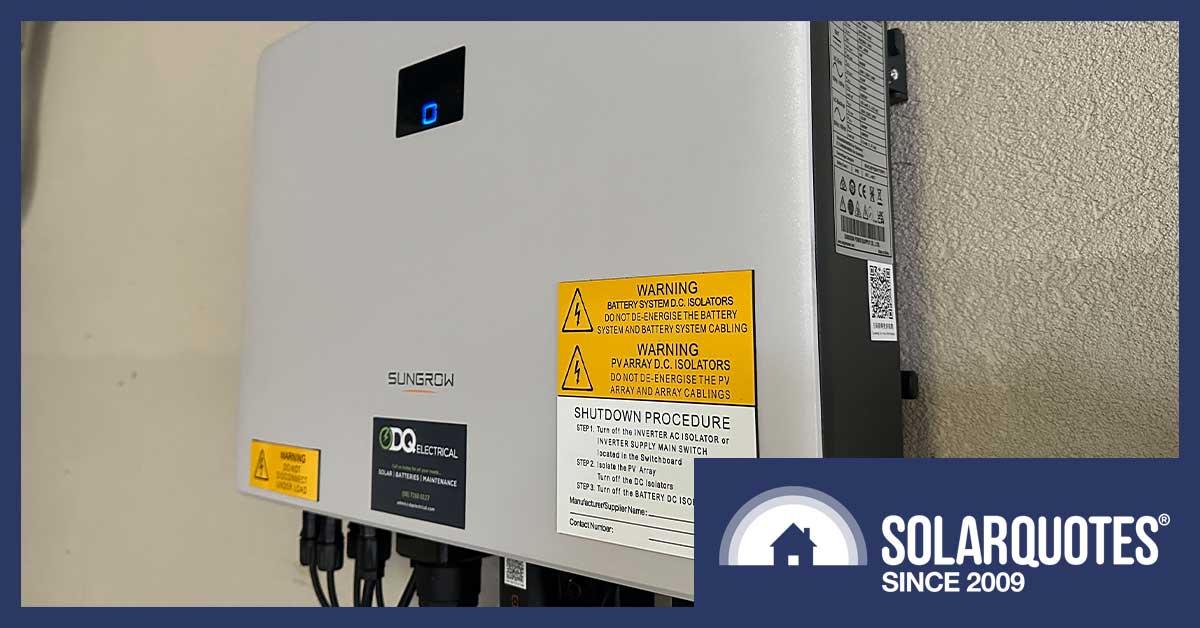
**Please note battery capacities in this article have been corrected since original publication 1/8/2023; however a new range of Sungrow SBH batteries are now available**
This post is part of our reviews of hybrid solar inverters – which when paired with a battery – can be good Tesla Powerwall alternatives. Here, I’m taking a closer look at the Sungrow SH5.0RS.
The catchy name SH5.0RS stands for Sungrow Hybrid 5.0kW Residential Single-Phase.
Compatible With Sungrow Batteries
The newest generation of hybrid inverters from Sungrow now pair with high-voltage DC batteries manufactured in-house.
The SBR series starts with a minimum of two 192volt 3.2kWh nominal bricks (and a spacer to make the stack physically 3 modules high)
Up to a maximum stack size of 6 (19.2kWh):
With further expansion of up to four parallel banks of 6 (76.8kWh):
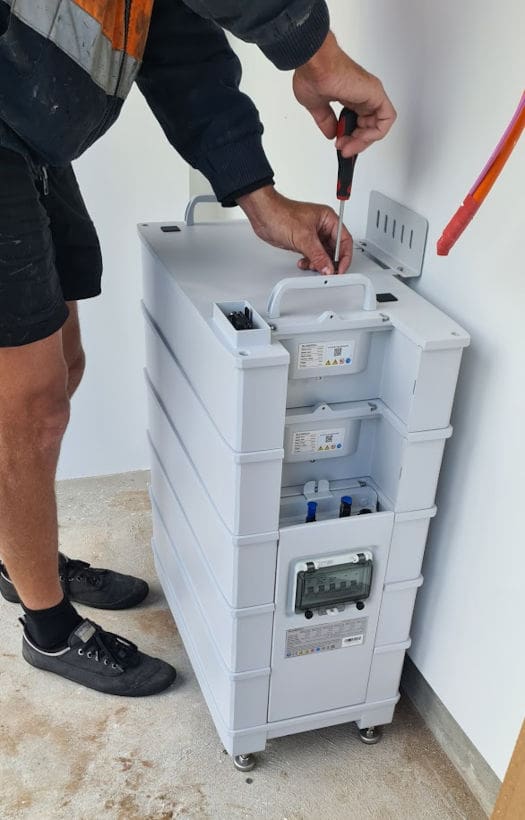
This stack of bricks can have another 3 stacks added side by side
Sungrow also have a new range of SBH high voltage batteries available, with 50amp charge and discharge ratings, which are better suited to larger sized installations than the 30 amp SBR series.
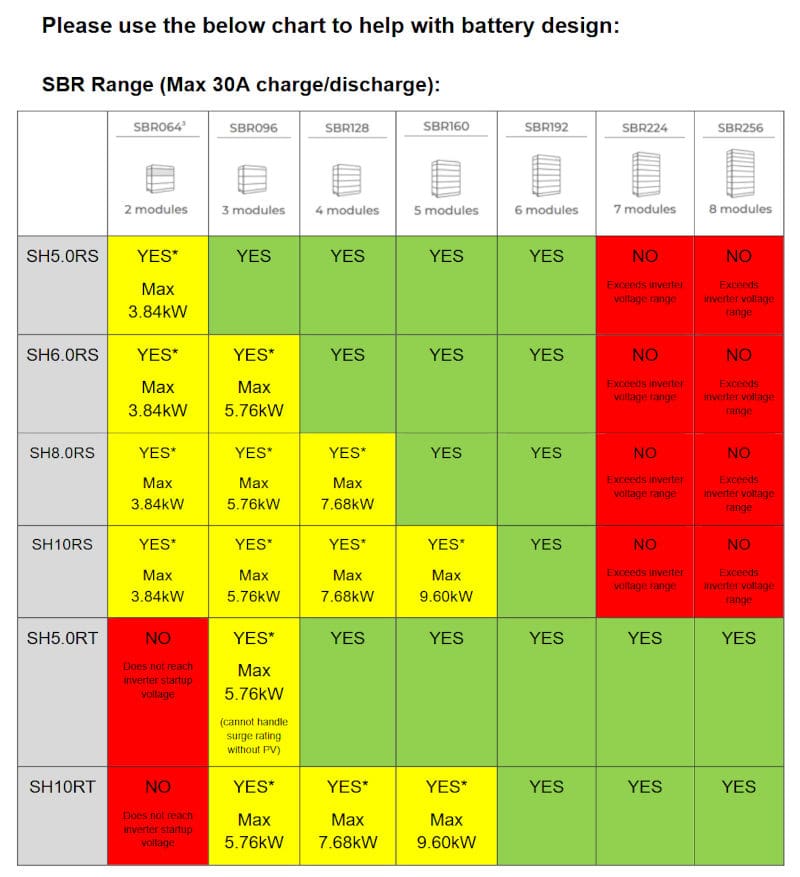
This chart helps clarify Sungrow capacities and compatibility
Easy To AC Couple More Solar Inverters
The ability to integrate another AC-coupled solar inverter makes these units much more attractive. You can either have legacy solar on the grid side or more Sungrow AC-coupled inverters on the backup side of the system.
This means the extra solar inverter (rated not more than the hybrid) can power loads directly – without bothering the battery. Great news if you want or need more daytime surge capacity. Better yet, the full-rated specifications available with a battery hybrid means you can load a Sungrow with 200% solar. That’s potentially 20kW of panels on the roof with a single-phase connection.
Ten Year Warranty
The warranty is specified as 10 years, and they even offer limited support for off grid operation, not that I would recommend it for anything but the most modest application.
If you want to know how Sungrow’s warranty compares with other manufacturers, Ronald has researched Sungrow inverter warranties extensively.
Current & Voltage Ratings
The SH5.0RS has far greater surge capacity and is a little more flexible in solar terms than Sungrow’s previous hybrid inverters. As panel wattages trend upward, solar current outputs are going up more than voltages, so the inverters are now given a suitably lower opening voltage window and more importantly, greater current ratings.
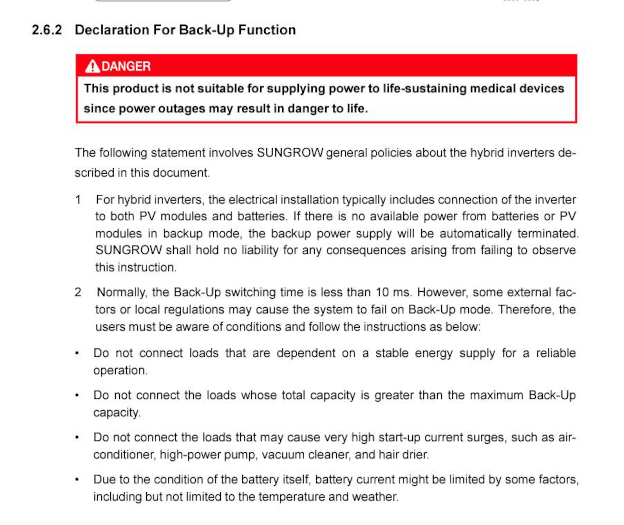
While some may claim UNINTERRUPTIBLE Power Supply, there is a well-defined difference between a UPS and an EPS system. So if you have critical applications, a hybrid inverter of any brand or type may not fit the bill. Props to Sungrow for being honest about it.
High Voltage Batteries
All new generation high voltage hybrid inverters use lower current, so they require much lighter cables from the inverter to the battery, and long cables will suffer less voltage drop. This means the batteries can be placed further away. These advantages come with a small trade-off in the form of an extra layer of complexity (and point of failure) in the battery management system compared to the older low-voltage models.
Backup Is *In Series* With The Grid.
Lighter, cheaper cables become important when you realise that Sungrow (amongst many) wire the Emergency Power Supply through the inverter. That means you may need a large and expensive pair of cables to run:
- the supply to the inverter and
- the backup load from the inverter
…both to the main switchboard.
Putting the inverter near the switchboard and moving the battery some distance away to an AS5139 compliant battery location reduces the cabling expense and minimises the voltage drop problem.
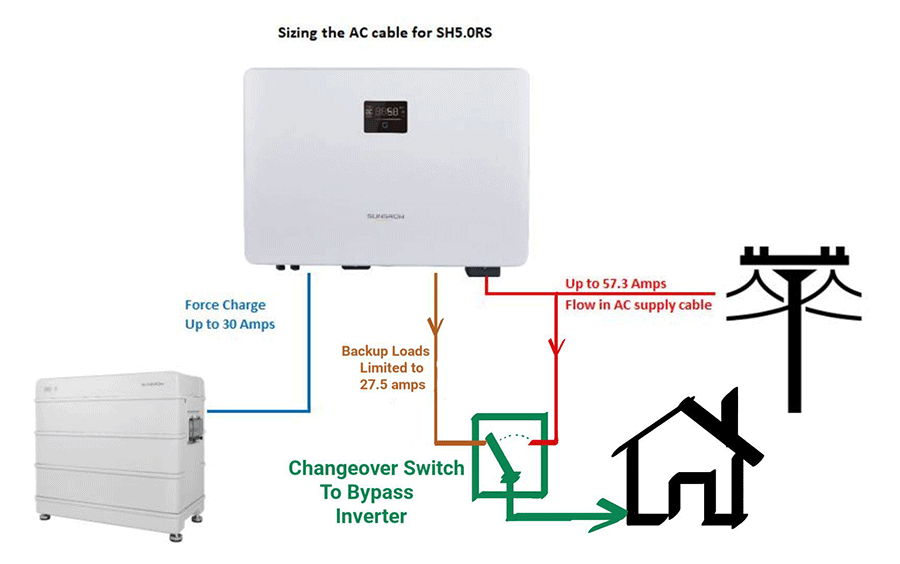
Heavy cables are needed to AND from the inverter. A manual changeover switch is also a great idea to bypass the inverter entirely if there’s a fault.
Why Not Backup *In Parallel* With The Grid?
Suppose you instead choose an inverter that operates in parallel with the grid, like the Fronius Gen24 or SolarEdge. In that case, you’ll only need one decent-sized supply cable, potentially freeing up the positioning of the whole system.
What’s the catch? The changeover time might be 3 or even 30 seconds – compared to ~20 milliseconds changeover with the Sungrow.
You can argue a long changeover is a feature, an unmissable analogue warning that the grid is gone and you need to curb your consumption. Still, many will prefer the seamless changeover of a Selectronic, Sungrow, Goodwe or Tesla system.
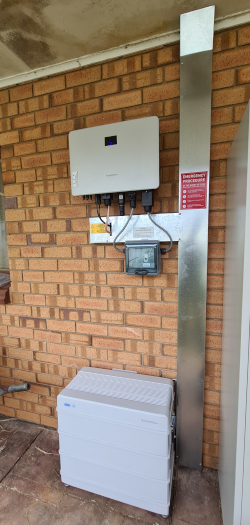
The metal cable tray is adaptable for carrying at least six cables into the roof, while the battery below only has two cables. image credit Solar Depot
Connectivity Is King
The new Sungrows have a tiny screen, relying on the monitoring platform to communicate. This makes them more heavily dependent on a good internet connection to monitor their behaviour and for installers to set them up. With the advent of flexible export connection agreements, mandatory in South Australia, optional in Queensland and coming to Victoria soon, having a solid internet connection is essential.
There are options for wired internet, WiFi dongles, and a 4G dongle that accepts a SIM card if you don’t have a local network. Annoyingly, the internet hardware only has a two-year warranty, which, as the system warranty relies on internet connectivity, strikes me as a rort.
While self-consumption is the name of the game in solar, exports are still handy for helping defray daily access charges. If your system is enrolled in Flexible Exports (mandatory in SA, opt-in in QLD, likely coming soon everywhere else), you may occasionally find you’re not allowed to export, but without a data connection, your system will be throttled to 1.5kW or even zero export.
Crucial tech tip.
When commissioning a Sungrow select the Australian server. Many clouds have been yelled at and many hours have been wasted when someone has missed this critical step early in the connection procedure.
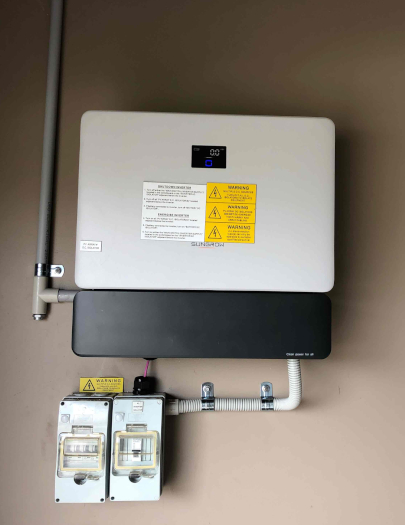
Sungrow now offer the black cover shown here to tidy up the multitude of things hanging off the bottom of the inverter. I would still put all the statutory jargon labels on the wall though.
Sungrow Monitoring Is Marvellous
The iSolar cloud app has plenty of detail and will allow you to program parameters for forced charging or limited grid input, depending on your preference. I have also seen a much slicker user interface in beta testing, which will be released soon. Installers quite like the range of features available with remote access, which can save service call fees.
Kim recently compared Solar Analytics vs Sungrow iSolarCloud, and as an ex-installer he preferred the Sungrow monitoring.
Simple Energy Management
The inverter has a single relay output that can be triggered for energy management duties such as activating a hot water service. Sungrow has also been testing in their Australian warehouse, so off-grid with generator support is available. Still, I must reiterate this shouldn’t be considered a true off-grid solution.
Full Three Phase Compatibility
Single and 3-phase consumption meters are available. Like the Fronius Gen24, Sungrow offers a 3 phase variant in this range of hybrid inverters, which I will endeavour to cover in an upcoming post. So if you have a particular 3-phase load or premises spread across all 3 phases, they can be backed up.
Be aware though, the Sungrow 3-phase hybrid inverters have less surge capacity for single-phase loads than an equivalent single-phase hybrid inverter.
Sungrow Is A Solid Choice
I have first-hand experience installing these machines, and while wiring up all the connections into a mess of plugs is a little tedious, everything is sealed with an IP rating, so it’s well-executed and weather tight.
Commissioning works well once you’re familiar with it, and the ability to zoom in on the graphs produced by the monitoring app is a real feature for this energy nerd.
My experience of Sungrow’s technical support has been historically fair to good, but it’s progressing to stellar. (They appear to be ramping up help available, so we’re not getting a foreign language answering machine anymore)
Have a look for yourself though; our Sungrow inverter reviews can be filtered for time, star rating and even wordiness, so you can see how the ratings have improved over three years and glean insight from end users just like yourself.
SH5.0RS: Technical Specs
For this comparison, I’ve specified an SBR128, i.e. four battery units, for a total 12.8kWh useable storage capacity. Warranty is 60% capacity at 10 years or 53.76MWh throughput. Happily, if you cycle it every day, this unit won’t exceed its throughput limit before the time is up on the 10-year warranty.
- Nominal capacity: 5kW (plus another 5kW with optional AC-coupled solar capacity)
- Surge rating: 8.4kW
- Solar capacity: 12kW
- PV current input: 16a nominal – 20a short circuit – each on two channels
- Usable Storage Capacity: 12.8kWh
- Warranty: 10 years – 60% battery capacity remaining – 53.76Mwh throughput
- Throughput limit @ 1 full cycle per day: 11½ years
- Approx retail: $15041 + installation
- $-per-usable-kWh: $1175
- $-per-warranted-kWh :$0.279 @ 1 cycle per day / $0.139 @ 2 cycles per day
- Three-phase option available with different specifications

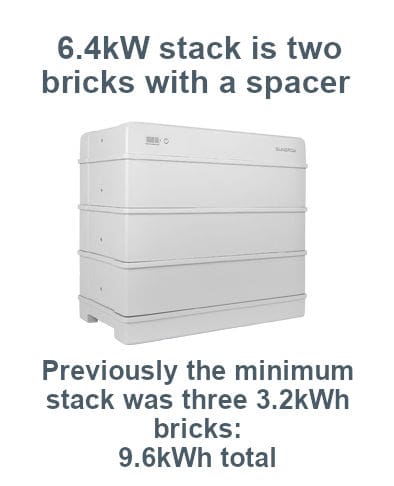
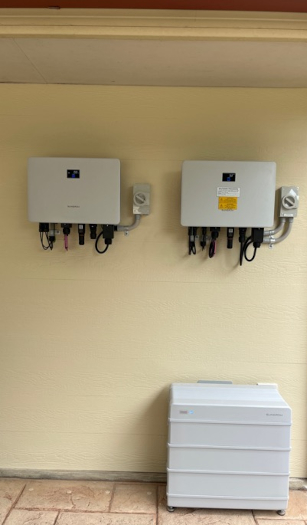
 RSS - Posts
RSS - Posts



Great to see that these inverters can control loads such as hot water and divert surplus otherwise-lost-to-low-FIT power. This makes low cost and reliable resistive HWS even more financially attractive than high cost heat pump HWS , if you have a reasonable sized PV array.
Hi. You have the battery capacities reversed, 2.3 kWh rather than 3.2 kWh. Great article, regards.
thanks! fixed.
Hi dear thanks for the valuable information I have a question if you have time to answer I will appreciate, I need an inverter that supports zero export to the grid in other words I don’t want even the electricity providing company to know that I have solar panels so which inverter you recommend for three phase around 25 KW?
Thanks for answering
25kW peak output? 25kWh/day?
If your inverter is network connected, even if it’s set for zero export, the DNSP must be notified.
If they work out you’re hooking up things that aren’t approved they’ll start by disconnecting you and then probably have you charged under the electricity act.
It’s taken pretty seriously.
Thanks.. 25 KW solar panels.. am not in Australia there are no regulations here .. which inverter is recommended for 3 phase zero export .. thanks
Hi Walid,
I’m pretty sure you could get a reasonably priced Sungrow or Goodwe unit for that application. Outside Australia you can run to full manufacturer specifications with might be 150% or 200% of the name plate capacity so 15kWp inverter would suffice. Goodwe offer a battery hybrid in that size, Sungrow are releasing one soon. They’ll need a consumption meter and appropriate settings to make them zero export.
What level of backup do these provide? Can you run the backup circuit with the power disconnected?
Can these be installed in parallel to provide more backup power?
Hi Christopher,
This is the more general information about hybrids but yes the Sungrow does offer backup on a series connected circuit where everything you deem essential is wired through the inverter. You can also connect more sungrow units on the backup side to offer more backup when the sun is out.
https://www.solarquotes.com.au/blog/powerwall-alternatives-hybrid-inverters/
This link below has an explainer under “know your DNSP limits”
https://www.solarquotes.com.au/blog/tesla-powerwall-alternatives/
This is my favourite
https://www.solarquotes.com.au/blog/selectronic-sp-pro/
https://www.solarquotes.com.au/blog/solar-switchboard-upgrade-guide/
Note that if you run two or more Sungrow SH5.0RS inverters in a master/slave setup and you have a stack per inverter (or just multiple stacks into more than one inverter) this limits capability of third party integrations such as Solar Analytics, Home Assistant or Amber, for example, as they don’t support it and Sungrow aren’t exactly fast at releasing API or MODBUS control over the batteries to allow forced discharging or even easy ways to stop the system providing feed-in to the grid.
You have “6.9kW” as the minimum Sungrow battery stack, it’s 9.6kW, wrong way around!
thanks – fixed
I am in the process of organising an install of a 6.6kW solar power system and Tesla Powerwall 2 to be AC coupled together.
The installer is a platinum rated SQ supplier. The lead was generated from this site. Thank you, Finn and SQ team!
Here are the main components:
6.6kW solar system with 13.5kWh battery storage
• Jinko Solar Tiger Neo JKM440N-54HL4-V (440W) 15x Panels
• Enphase IQ8AC-72-M-INT (0.37kW) 15x
• Tesla Powerwall 2 (13.5kWh)
Cost ~ $23K
Cost of PW2 Installed ~ $16K
This is for my mum and dad’s property, and they both pensioners.
They were able to secure the Solar VIC battery rebate before 30 June 2023, and the above costs are after the rebate is applied.
Could I further save them more money by switching out the PW2 with the Sungrow setup described in this article?
Under SH5.0RS: Technical Specs you write:
Approx retail: $15041 + installation
This is using the SBR128 unit with a usable storage capacity of 12.8kWh (just 0.7kWh less than a single PW2 output).
I am unsure if the switch over from Tesla PW2 to an equivalent Sungrow system will be a huge saving.
The only other advice I have been given was to get rid of the microinverters, which I am reluctant to do as the panels
are to be installed across multiple parts of the roofing. Yes, I know Fronius inverters support multiple strings but you
still do not get panel level monitioring.
Any thoughts on whether the SH5.0RS + SBR128 would be a good substitute for the PW2, and can be AC coupled to a Jinko + Enphase IQ8AC
solar power system?
Hi Sam,
You certainly can have a Sungrow as an AC coupled unit with external solar inverters. You may find it beneficial to have your enphase system to cover small arrays facing different directions but I would also add some DC coupled solar to the Sungrow inverter to give you black start, apocalypse proof autonomy in case there is an extended blackout. DC coupling is inherently efficient and if you have the roof space there is potential to add up to 20kW on a single phase using Sungrow. They also have 8 & 10kW single phase units coming out soon.
Hi Anthony,
Thank you so much for your insights.
As you have correctly pointed out, unlike the Tesla PW2 the Sungrow hybrid inverter supports black start for a flat battery.
This will require a string of DC panels. From what I can see, the minimum MPPT voltage is 40V. This means I would need to have
at least 4x 440W Jinko panels wired up directly to a string.
It is starting to look like the microinverters will need to be ditched if the installer doesn’t agree with this hybrid solution.
Is there any other way of achieving black start when the grid is offline?
Also, considering the recent Tesla PW2 price drop (via the $750 rebate application until end of 2023), is it still worth considering
the Sungrow stack (SH5.0RS Hybrid Inverter + SBR128 DC Battery)?
Regards,
Sam
Hybrid inverters are a great emerging technology, particularly now they can do 3 phase. But i would Fronius any day. Chinese owned inverters like sungrow present a clear security risk
“Chinese owned inverters like sungrow present a clear security risk”
Would you care to elaborate what these security risks might be in a residential and non-government use scenario?
Should I also be worried when I fly my DJI drone for my roof inspections?
Hi Sam, while all inverters that are internet enabled have the capability to be hacked. Chinese-made inverters present a higher risk as the Chinese Government has laws that allow them to force manufacturers to include vulnerabilities and report data.
For a residential or Non Government use, this could mean hacking some data on the same WIFI networks, or they could hack a thousand or 10 thousand at the same time and cause a major disruption.
In regards to your DJI drone, it’s your call but i think they’re the ones the army just banned as they also had these drones. But i doubt it’s as risky for a roof inspection.
This is the primary reason that I’m hesitating to get a Sungrow inverter – everything else about them looks like they would suit my requirements very well!
Hi Joss, I was the same as you. the Chinese inverters are great on paper, have good warranty claims, efficient, affordable, but I couldn’t overlook the risk. I thought I pay $300 a year for anti-virus for my computer. Would i pay an extra $1500 for a European inverter that I’ll have for a decade, makes sense.
What are your thoughts on the Sungrow SH10RS?
Thanks so much!
Hi Carol,
I haven’t clapped hands on the new 8 & 10kW single phase units but I’m aware they’re in Australia and being tested in the field. Likely a good device that installers are happy to have decent sized terminations on the plugs to install the fat cables required.
Hi Anthony,
Thank you for this informative review. Just remind you that the title should be “SH5.0RS” for single-phase.
Bill
Thanks Bill
All sorted.
Hi Anthony,
I have 6.5KW Panels & a 9.6KW battery.
My battery rarely goes below 90% capacity as I am very frugal with energy.
What would be involved with going completely off grid?
Thanks,
Pete
Hi Pete,
I don’t encourage people to go off grid, especially not with a garden variety hybrid, they’re just not built for it.
Unless you start with a Selectronic SpPro. They’re built for anything.
For off grid you need large batteries to give you autonomy for days, and then a generator for backup… which is the most unreliable part of any off grid system.
The grid is more reliable, quieter and cheaper. If you have a proper diesel generator serviced once a year it will cost more than the grid just for the service, even without putting fuel into it or a cranking battery every couple years.
Grid connections offer some payback that a genny doesn’t.
Thanks for your response Anthony.
It’s been all a little discouraging. Till Feb this year, I had only 3KW of solar panels, NO battery & was receiving credits.
Then I paid $14,000 to extend to 6.5KW solar panels & a 9.6KW battery & now I am getting bills.
The only electricity I use is:
the fridge, tv for a couple of hours at night & washing machine once a week.
I use oil lamps at night & have gas cooking. My water is heated by the panels during the day with a timer.
How is this all a good thing? And just where & when will the extortion end?
Pete
@Pete For a conservative consumer such as yourself, you shouldn’t be seeing any power bills after that battery installation.
May I ask what the make and model of your solar battery is?
Also, from your electricity bills, could you tell us how much kWH energy are you using per month on average (just the usage component)?
Hi Sam,
My Battery is a Sungrow SBR096.
My average monthly KWH is 65. Though reading some of the posts from Origin Energy, customers are reporting the readers are amplifying the numbers purposely to sow distrust which then encourages people to sign up for smart meters.
My battery rarely goes under 90%. The only appliances I use are the washing machine (once/week) & a rice cooker (once/week). Even though I use these during the middle of the day, these are the only days I have noticed that my battery depletes to about 70% later that night.
SO here is a question I have just purchased a sungrow as per this article but I cannot seem to stop it taking form the grid when the grid is available so my battery stays at 100% and only gets used when the power fails but I only want to use power to charge the battery or feed my loads when the battery is below 40% (used to do this quite happily on my older SAM system.
What am I doign wrong ?
what have I missed ?
This is supposed to be configurable as off grid or week grid/generator but even in this mode it still uses mains power/genrator as the prefered option oif available.
the manual and supplier have not been helpfu
Have followed a rabbit hole back to this blog. Your post is somewhat aged, but doesn’t seem to have been answered.
There are 2 reasons that i see that could cause your battery to NEVER go below 100%SoC.
It might be set to force charge to 100%. I have actually done this quite a few times to test the amount Dischargeable from battery 100% Soc to fully discharged, so have programmed a forced charge to 100% SoC until midnight. [Results not good btw]
Yours might be set from 00:00hrs to 24:00 hours.
In app, from the three horizontal bars top right,
– select DEVICE
– Select ENERGY STORAGE SYSTEM
– scroll to right, select SETTINGS
– select ENERGY MANAGEMENT PAREMETERS
– at bottom of screen see FORCED CHARGING. Ensure “Readback value” is DISABLED. if enabled change to Disabled.
Or, more likely, the SoC% for back up in event of grid failure might be set to 100%.
– After going to SETTINGS as above, select POWER CONTROL.
At bottom see “BACKUP MODE”. This should state ENABLE. But select ENABLE anyway. Then scroll to next line which should be “RESERVE BATTER SOC FOR OFFGRID”. Set/change this to what ever you wish, maybe the 40% you referred to. If it states “100%” that was your problem.
The INSTRUCTION VALID PERIOD is the length of time the app will try to execute the instruction before it lapses. I use .5 hour but check back to make sure the READBACK VALUE has changed to what I intended.
I have been told that after changing any of these settings one should also run QUERY PARAMETERS, the orange box at bottom of app.
Hope that helps.
Looking to upgrade my 10yr old solar system which is on a single phase in Perth.
Current system is Aurora power 1 5kw inverter and 25 REC 250w panels.
This system has been very good for the last 10yrs with the inverter being replaced once and it has averaged 16.69kwh export per day over the last 2 years.
I’m looking to get a battery and hybrid inverter to be able to use this energy at night time.
I have been quoted $22990 for a Sungrow hybrid sh5.0rs+ sungrow 19.2kwh battery and 26 x risen 440w n type with blackout protection on 2 circuits.
Is this a good price and a reasonable system or would I be better leaving the existing panels (which work fine) and get either the sungrow inverter and battery. I know that the the winter time solar production with the old panels would not be enough to fill the battery and I would supplement this with a cheaper tarriff by importing from the grid.
Do you know if it’s possible to connect Enphase IQ7+ microinverters to the backup side of the Sungrow RH10RT to allow the Enphase kit to produce energy during a grid outage and charge a Sungrow SBR battery stack?
It seems possible with the Victron low voltage DC inverters.
https://enphase.com/en-gb/download/ac-coupling-enphase-iq-microinverters-victron-battery-inverters-tech-brief
Good question Ryan,
I’m pretty sure they will respond to frequency shift but I’ll ask around.
Hi,
I’m an installer considering switching to these hybrid Sungrow setups.
The system I have been previously using featured black start capability.
From what I can see from previous comments, these don’t have that feature but you mention a separate DC coupled mppt could achieve this. Any tips, I’d usually use a Victron MPPT but voltages, charging algorithms data etc. would be a bit unkown for me for a battery like this
Cheers
Steve
Hi Steve,
What are you normally installing for? There’s nothing available in terms of MPPT for a 300volt plus battery.
If it’s a remote area system you normally build then I wouldn’t recommend a lightweight grid hybrid, even though to the best of my knowledge they do black start. Victron are perhaps 200% surge capacity but a hybrid will only make 120% so they struggle to start a motor.
What happened to the 75% oversizing limit in Australia, ie a 5kW inverter not being allowed to be connected to anything over 6.6kW of panels? I had an installer yesterday saying this standard is still mandated to get your credits paid, but this review is promoting connecting the full 10kW of panels?
Coincidentally another local installer had no issues quoting me for just off 10kW of panels on a 5 or 6kW Sungrow hybrid inverter.
My house is single phase connected, in an aussie grid with a strict 5kW export limit.
If you have a DC coupled battery there is no limit apart from the manufacturer’s spec:
https://www.solarquotes.com.au/blog/beat-solar-oversize-rule/
With the SH5.0RS inverter it only supplys an emergency circuit during a loss of the street supply so it would be no good for using that excess battery storage during the night to offset the peak loading, would that be correct? In other words you can only use the battery for emergency use only.
Hi Karl,
Sungrow hybrids mean when you turn something on in the house it will use solar (if available) then revert to battery (if chargerd) then as last priority import grid energy. You can use the battery anytime day or night, with or without the mains.
https://www.solarquotes.com.au/blog/hybrid-solar-bypass-switch/
https://www.solarquotes.com.au/blog/powerwall-alternatives-hybrid-inverters/
Hi Anthony,
Could you clarify how the backup and normal night time battery power works ?
At the start of the article you said it’s only good for the most modest off grid application and the linked sungrow backup capacity document says SH5.0RT: max 1.67kW per phase in off grid mode. Is offgrid mode the same as blackout protection? It then says in the same doc that the backup circuit will operate continuously on grid if the load is < 18.5A per phase. But the picture in the article says max backup load is significantly more at 27.5A.
The spec sheet says 27A and 6000w for "backup data on grid mode", which I assume actually means that during normal on-grid operation the inverter can draw up to 6000w from the battery to supply the general loads of the house before it imports power from the grid. Is that right ? The spec sheet also says 5000w backup off grid mode, so seems to be some conflicting info.
So the question is, assuming I've got a big battery, what can the inverter actually deliver to loads of a night under normal operation without drawing from the grid?. And what can it do during a blackout, because ideally I'd want one of the main house power circuits wired as essential power to be available during an extended outage in addition to the fridge and lights.
Thanks!
Hi Jay,
Have a look at the spec for the newer 8 & 10kW Fronius Gen24 or Sungrow units. They’re designed to do “whole home” backup.
https://www.solarquotes.com.au/blog/powerwall-alternatives-hybrid-inverters/
https://www.solarquotes.com.au/blog/fronius-gen24-review/
https://www.solarquotes.com.au/blog/sungrow-hybrid-inverter-review-2023/
https://www.solarquotes.com.au/blog/selectronic-sp-pro/
Hi. I made it back to this older blog from link in another of your excellent commentaries.
If I made be so bold, I suggest you don’t perpetuate the myth that the Sungrow batteries’ capacities are fully usable. There is not 12.8kWh of usable energy in a SBR128 as the allowed depth of discharge is not 100% even when the SOC% for backup is set to 0%. There is a reserve of 5% that Sungrow say is “hidden”.
Of course the batteries might be 5% more than stated, but in my experience this denlfinitely is not the case and Sungrow would say so if it was, I assume. But would love to be proven otherwise.
The Sungrow SH5.0RS Datasheet (DS_20240111_SH5.0_6.0RS_Datasheet_V13_EN(AU).pdf) includes
“Recommended max. PV input power 12000 Wp”
“Max. AC power from grid 12000 VA”
“Max. AC output apparent power 4999 VA”
“Backup data ( on-grid mode )
Max. output power for backup load 6000 W”
“Battery data
Max. charge / discharge power 6600 W”
Now, does this mean that the inverter, in having oversizing of a factor of 2.4, being able to manage 12kW of panels generating capacity, can take the power from the panels, and, use it to generate up to 5kW A/C power, and, direct up to 6kW into battery charging, concurrently?
Also, do those specifications mean that the inverter can satisfy household load of up to 6kW A/C power, from the battery (“when the sun has gone down”, and, sufficient energy is available from the BESS)?
I am in Armadale, an outer suburb of Perth, WA, where, being on the SWIS grid, we are on the only electricity grid in Australia, that does not allow single phase 10kW inverter capacity.
Also, the electricity supply is unreliable, unstable, and, unsafe.
So, I have the whole of the household (apart from the bore pump and the electric booster element for the SHWS (the state government has now, also, effectively, banned SHWS’s in WA) ), on the protected circuit, with a Goodwe GW5000EH inverter, and 19.3kW of BYD HVM BESS (which the Sungrow inverter shows as being compatible with that inverter, also), and 8.36kW of panels, and, the limit of 5kW power supply for daily household load, is a bit difficult, sometimes, so, I am wondering about the apparently more powerful SH5.0RS, which would also allow more panels capacity, to help through less intense solar power availability days.
Thus, the question of whether the SH5.0RS can provide 6kW A/C power at night, becomes significant, in addition to the other questions.
Hi Brett,
A 5kW Sungrow is still only a lightweight grid hybrid machine. They’re fine for what they are and having 12kW of solar does make them pretty capable in low solar insolation times of day.
However if they specify 6kW max (120% rated capacity) then that’s what they’ll surge to for 10 seconds when the grid isn’t available. For memory the backup circuit is good for 27amps whether the grid is there or not. They’re not designed for whole house backup.
The 10kW Sungrows are much more capable with 63a pass through and 40a backup.
If you’re serious about reliability and sticking it to Western Power, I’d talk to Jae Taylor about a Selectronic system. A 5kW SpPro will deliver 21 amps all day long and surge to 50a (ie 240% over the sticker rating) They’re legal to install as a grid hybrid with 63amp pass through and zero export. Plus you can have as much solar downstream as your heart desires.
The datasheet for the Sungrow SH5.0RS single phase hybrid inverter is found here
https://aus.sungrowpower.com/productDetail/2177/power-conversion-system-hybrid-inverter-sh50-60rs
“Backup data ( on-grid mode )
Max. output power for backup load 6000 W
Backup data ( off-grid mode )
Rated output power 5000 W / 5000 VA
Peak output power 8400 VA,10 s”
So, it seems to me, that the 10s peak power output, is the 8.4kW, and, it appears to me, that the “backup load”, which I assume to be the load on the protected circuit, can be up to 6kW, continuous load.
With your comment
“The 10kW Sungrows are much more capable with 63a pass through and 40a backup”
I would prefer a 10kW hybrid inverter, especially, given that the single phase grid connection fuse is 63A (approximately 15kW), but, as I stated, we are on the shonky SWIS grid, the only grid in Australia, on which, the allowed single phase inverter highest rating, is 5kW. Western Power and the state government, are hostile to households using clean energy.
Hi Brett,
Thanks for the details. Interesting that Sungrow seem to have improved surge rating to around 160% on the 5kW models. Also I note they have the same surge rating across all models from 3 to 6kW, indicating that surge is limited by the ability to dissipate heat.
Sungrow are pretty up front about the temperature their fanless inverters can climb to and I applaud the fact they publish data like this : https://service.sungrowpower.com.au/files/Web_Files/GD_202012_Why%20Inverters%20Get%20Hot_V1.2.pdf However I’ve seen hard working machines running at 80°C internal temperature and they struggle. The rule of thumb is a 10°C increase in temperature can reduce the lifespan of electronic components by half.
The rating for 6kW pass through relies on the grid supply and is a reason why Sungrow hybrids need an input circuit rated to deliver at least 57amps (27 for the essential circuit and another 20a to force charge the battery)
The block diagram shows the internal topology of the inverter will allow DC current from the solar array to charge the battery without involving the AC conversion stage. This is great for efficiency and allows a potential for 6kW of solar to AC loads plus an additional 6kW to the battery under perfect conditions, but it does make for confusion when the nominal rating for the inverter is between 3 & 6kW
As mentioned, using a DC coupled system means you can meet Western Power or SWIS rules and still have as much solar as you want.
A response received from Sungrow technical support, includes
“With regards to the 6kW output into the backup circuits, that is only during on-grid operations (i.e. when there is no power outage).
The new user interface does have the battery state-of-charge ”
So, apparently, while the grid supply is operational, the inverter can supply 6kW continuously to the protected circuit, but, that drops down to the 5kW, when the grid supply fails.
Also, in the article above, whilst (I believe) no mention of it is made, the inverter is compatible with BYD HVM batteries.
Apart from the email message from Sungrow, including an attachment showing the monitoring displayed output including battery State Of Charge (SOC), I have not seen any other image where the SOC is so displayed.
I initially bought Growatt SPF3500 as wanted flexibility with batteries. Growatt support was OK and we could even have technical conversations. Had to return those due to excessive noise.
I settled on SH10RS that is the only one I know is fanless. 4 MPPs and larger input voltage range also solved difficulties with panels configuration. Then comes the bad part:
1. The device’s display, unlike with Growatt, is completely useless, obviously to make you install their App. If anyone is aware of software to talk to the inverter over LAN, please let me know; reliance on internet to manage local device is ridiculous
2. They revamped their website and graphs are now difficult to read due to fill.
3. The energy retailer accepted that they can’t force me into installation of a smart meter (NSW). I don’t want to cause any problems in the grid, and the installer somehow remotely configurd zero exports. Nothing in the inverter’s manual about that being done after the Plant is created. Now, the poor thing that claims over 97% efficiency reduces solar power the way my household drains around 300Wt from the grid, obviously to make sure there is zero export. Following logic in that device, shutting down also means zero export.
4. I sent email to [email protected] a few weeks ago with no reply.
5. Over a week ago I sent email to [email protected] with the same result.
6. I asked the installer to limit export to 500Wt, which will effectively export 200, well below allowed 5kWt, but seems like the installer does not know how to fix that and is likely in the same boat as myself.
I can only think of declaring the inverter ‘defective by design’, and putting there something else, but this is fanless design vs noise and unnecessary fail points.
So, I have to concede that by installing solar I’ve created more dependencies rather than becoming less dependant on the grid. Compliance everywhere and zero control from my end. Waiting for Solar Tax…
Anyone has a suggestion?
Hi Nick,
You’ve dodged a bullet with Growatt in my opinion. Sungrow are fine but you may just have encountered the fact that inverters aren’t perfect machines. While the inverter may well be zero export, the web based display is trying to average the readings from one split second to the next, and then display them in a coherent fashion without using too much data.
If you want true zero export then get a Selectronic SpPro. They’re the last word in reliability and simply not allowed to export because of AS4777 standards. They will however allow you to thumb you nose at the network and add as much solar as you possibly can.
We’ll have an article out on the broader subject soon.
https://www.solarquotes.com.au/blog/selectronic-sp-pro/
Thank you for the analysis Anthony!
Since my installer is as unresponsive as Sungrow Australian and Chinese offices, I tried to install their software as a distributor to regain control of what I think is MY property. Of cource I may be delusional about what is mine under the juristiction I exist.
Anyway, I could not manage that because the poor thing keeps complaining about some capcha which I do not see on the screen. After all the fom fields are filled the submit button disappears. Unsure what is their intepretation of CAPCHA is, and where it is coming from. I think I did not block China for subnet where my WIFI is, will need to double-check.
Returning to Selectronic SpPro, does it have fans to make noise and eventually fail? Would I have a full control over it rather than developing dependency on the installer like now?
Hi Nick,
You’d have to get yourself some instruction on how to use the configuration software, but the SpPro is as bolt honest as they come. There’s a monitoring portal available if you add a Select.live device but the SpPro isn’t an internet based machine.
You use the select.live to plug your PC into the inverter remotely so to speak… or you physically plug a USB lead in to make the connection yourself.
No internet required but no export from the battery to the grid possible under under current AS4777 rules.
In Fremantle I have just upgraded my PV: 16x 300W LG / SMA 5kWh to 13x 300W LG (string 1) 15x 410W Sungrow (string 2) to a Sungrow SH05.0RS with 2 x 12.6 kWh battery array . The battery SOC is about 60% at 7AM in August. My prediction was a system producing peak 27kWh in Jun. and peak 63 kWh in Dec. The daily Aug actual production was very close to my predicted peak 33kwh. My concern is SOC reaches 100% about 10:00 AM and then power switches to grid output, 5 hours prior to Synergy preferred export to grid time of 15:00. Synergy has a solar saver of 8.5c/kWh 9:00-15:00 import from grid and 10.0c/kWh export to grid 15:00-21:00 . Today 15/9/24 PV production drop to 100W just on sunset having been 1030W 30 min earlier. PV production hits 8.2kW when SOC hits 100% then drops to 4.9kW until declining light causes a steady fall in PV from 15:00 onwards ie at moment peak feed in tariff applies PV output is in decline.
It seems to me that by simply increasing each battery stack by 1 – 2 x3.2 kWh modules I delay commencement of export to grid closer to peak export time. But 30 min prior to sunset PV production drops below 1kW so I would need to force discharge from enlarged 32kWh battery to grid until battery SOC is about 16kWh / 50% about 3 hrs discharge to grid at 5kW.
Is it possible to discharge from battery via inverter to grid in the above setup ?
Have you looked into Amber’s wholesale pricing and SmartShift system? It’s much more exciting than being on standard tariffs, but it gives you near total control of battery charging and discharging, including feeding into the grid at peak times. They could do with a daily scheduling system but perhaps that will come.
News from Sungrow: Now they no longer support any HV batteries except of their own. They decided they are yet another ‘Apple’. Can’t wait to see how that backfires.
As for my Sungrow 1-phase Hybrid Inverter SH10RS, I can now claim that it is not fit for purpose as a Hybrid Inverter and get it replaced together with their meter. If someone wants it, I am taking bids.
I don’t see how I attach PDF, but it goes as “SH5.0~10RS, SH5.0~10RT Series, SH15T~SH25T Series Hybrid Inverters ,
ONLY support SUNGROW SBR& SBH series High Voltage Batteries,
Other brand high voltage batteries are no longer supported.”
According to sungrow cross reference chart the 5kw inverter single phase can be paired max with 19kw SBR series but your article says 25 kw SBR, any clarification of the discrepancy between both information? Thanks
For a single phase (SH**RS) the max is either SBR192 or SBH250
Hi, I have a Sungrow SH10RS and am awaitng for SBH250 battery to be installed. Can I recheck do I need to add any manual switch or transfer switch, etc, if I want to use the backup power during power outage? Thank you.
I have a switch to bypass the inverter in case it poops. Also asked the installer to install SPD to protect me from grid surges. They installed Type2 and on an active wire only LOL.
Just left 1kW heater overnight and my calculations based on reported load power and SOC Level show the actual capacity of the battery is 19.36kWh rather than 25. Likely because despite the request the installer put a salad of different batches into the battery.
Good luck with your installer mate.
P.S. I might stop participating in those discussions because that website keeps failing CAPCHA verification. New SolarQuotes owners do not have money for paid verificators like Temu uses.
Hi Gate,
Are you having technical difficulties proving you’re not a bot?
Every comment here gets eyballed by a human before publishing, but those people aren’t on call so times do vary.
Yes I do Anthony. Google is not happy when people do not want it to track them across every website under the sun. Even for the privilege of replying to you I logged to Facebook in another tab.
Also have to report that the SOC seems to be balancing, got 21actual battery kWt capacity today.